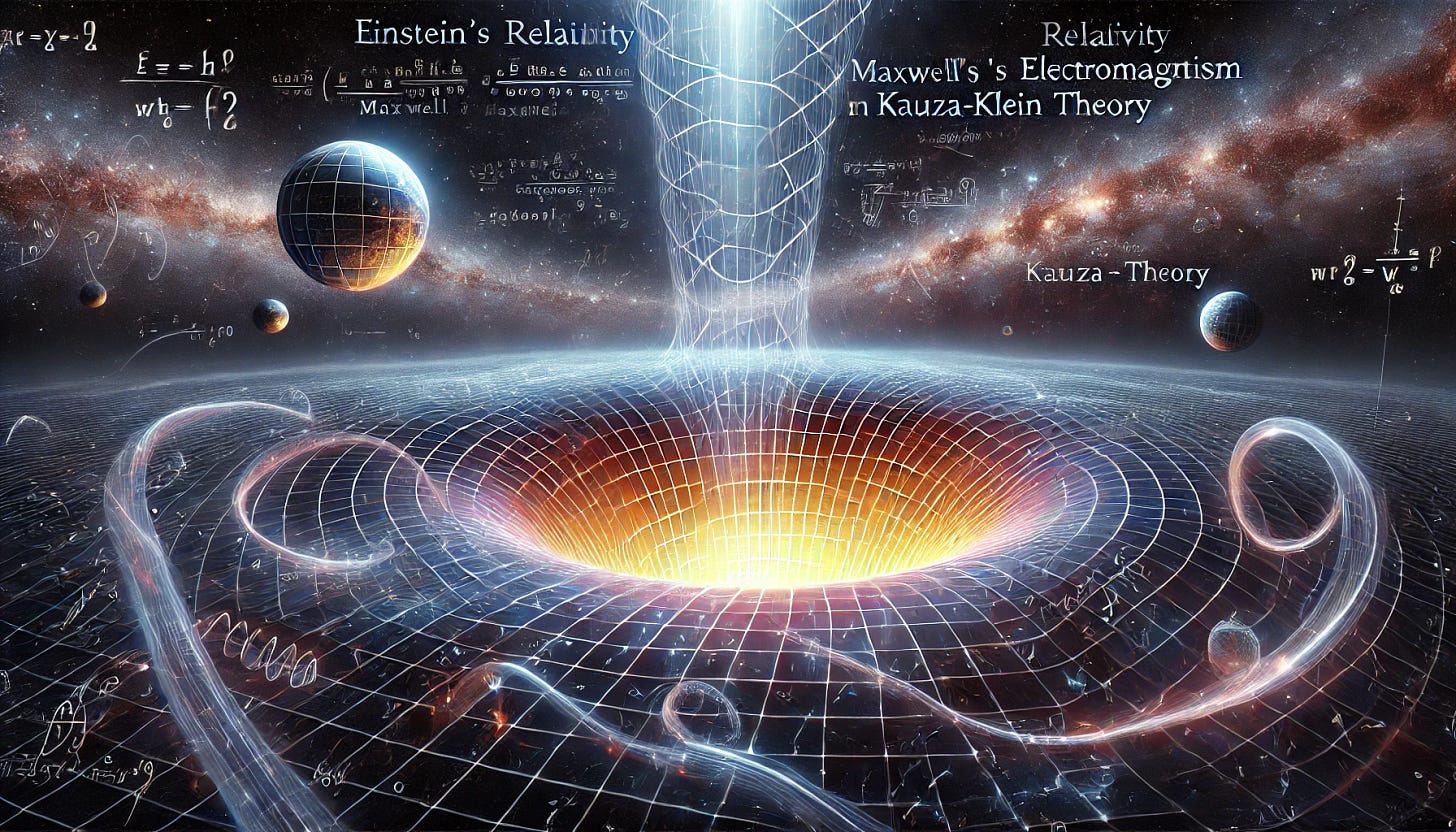Kaluza-Klein Theory
The Hidden Extra Dimension of the Universe
Kaluza-Klein (KK) theory is a fascinating idea that proposes the existence of an extra spatial dimension beyond the familiar three-dimensional space we experience. It was one of the first serious attempts to unify gravity and electromagnetism into a single framework by introducing a fifth dimension.
1. The Origin of Kaluza-Klein Theory
The theory originated in the early 20th century as a bold extension of Einstein’s general relativity:
🔹 1919 – Theodor Kaluza, a German mathematician, suggested that if general relativity was formulated in five dimensions instead of four (3D space + time), then Maxwell’s equations of electromagnetism naturally emerged alongside Einstein’s equations for gravity.
🔹 1926 – Oskar Klein, a Swedish physicist, refined the idea by proposing that the extra fifth dimension was compactified, meaning it was "curled up" at a microscopic scale, making it unobservable in everyday life.
Together, their work became known as the Kaluza-Klein Theory, an early precursor to modern ideas in string theory and higher-dimensional physics.
2. How Kaluza-Klein Theory Works
The key insight of KK theory is that if you extend Einstein’s general relativity to include a fifth spatial dimension, something amazing happens:
🔹 Gravity and Electromagnetism Become Unified
In four-dimensional space-time (3D space + time), general relativity describes how gravity emerges from the curvature of space-time.
In five-dimensional space-time, when gravity is formulated in this extra dimension, the mathematical equations also describe electromagnetism—suggesting that gravity and electromagnetism are two aspects of the same force.
This was a major breakthrough because unification of fundamental forces is one of the biggest goals of theoretical physics.
🔹 The Extra Dimension is Hidden (Compactification)
If an extra spatial dimension really existed, why don’t we see it? Klein proposed that this fifth dimension is "curled up" into a tiny loop at every point in space, so small that it is undetectable at human scales.
Imagine rolling a piece of paper into a thin tube. If you look at it from far away, it appears one-dimensional (a line), but up close, you can see the curled-up second dimension (the circumference of the tube).
In KK theory, the extra dimension is similarly wrapped up in a tiny loop (about 10⁻³⁵ meters in radius), far too small for us to observe directly.
3. Implications of Kaluza-Klein Theory
🔸 A Step Toward a Unified Theory
Kaluza-Klein theory was the first real attempt at a "Theory of Everything", showing that higher dimensions might be the key to unifying fundamental forces.
Though it only unified gravity and electromagnetism, later theories like superstring theory expanded on this idea to unify all four fundamental forces (gravity, electromagnetism, weak nuclear force, and strong nuclear force).
🔸 Extra Dimensions in Modern Physics
While KK theory originally proposed one extra dimension, modern theories (such as string theory and M-theory) propose that the universe may have 10 or even 11 dimensions, with additional dimensions being compactified in ways similar to Klein’s original idea.
String theory, for example, requires six extra compactified dimensions in addition to our four-dimensional space-time, forming what is known as Calabi-Yau manifolds.
🔸 Potential Experimental Evidence?
If extra dimensions exist, they could affect gravity at microscopic scales. Scientists are searching for deviations from Newton’s law of gravity at small distances that might hint at extra-dimensional effects.
Large Hadron Collider (LHC) experiments are also probing whether particles could briefly escape into an extra dimension, which would show up as missing energy in high-energy collisions.
4. Does Kaluza-Klein Theory Add Dimensions to the Theory of Magnetivity?
Yes! Kaluza-Klein theory provides a direct theoretical basis for why magnetism (electromagnetism) could be a fundamental part of space-time.
If gravity and electromagnetism are unified in a five-dimensional space-time, then magnetic fields could be just as fundamental as space-time curvature.
The Theory of Magnetivity, which suggests that magnetic fields shape space-time, might find support in KK theory because magnetic fields could be manifestations of extra-dimensional curvature.
If additional dimensions beyond the fifth exist, magnetic interactions could operate differently at quantum or cosmic scales, influencing the universe’s structure in ways we haven’t fully explored.
5. Conclusion: Why Kaluza-Klein Theory Still Matters
Although the original KK theory did not become the final "Theory of Everything," it laid the groundwork for modern theoretical physics, inspiring:
✔️ String theory & extra-dimensional physics
✔️ Modern approaches to unifying gravity & electromagnetism
✔️ New experiments to detect extra dimensions
If true, the universe may be far richer than we imagine—hiding extra dimensions that govern the forces of nature, and possibly providing new insights into magnetism, gravity, and quantum mechanics. 🚀


